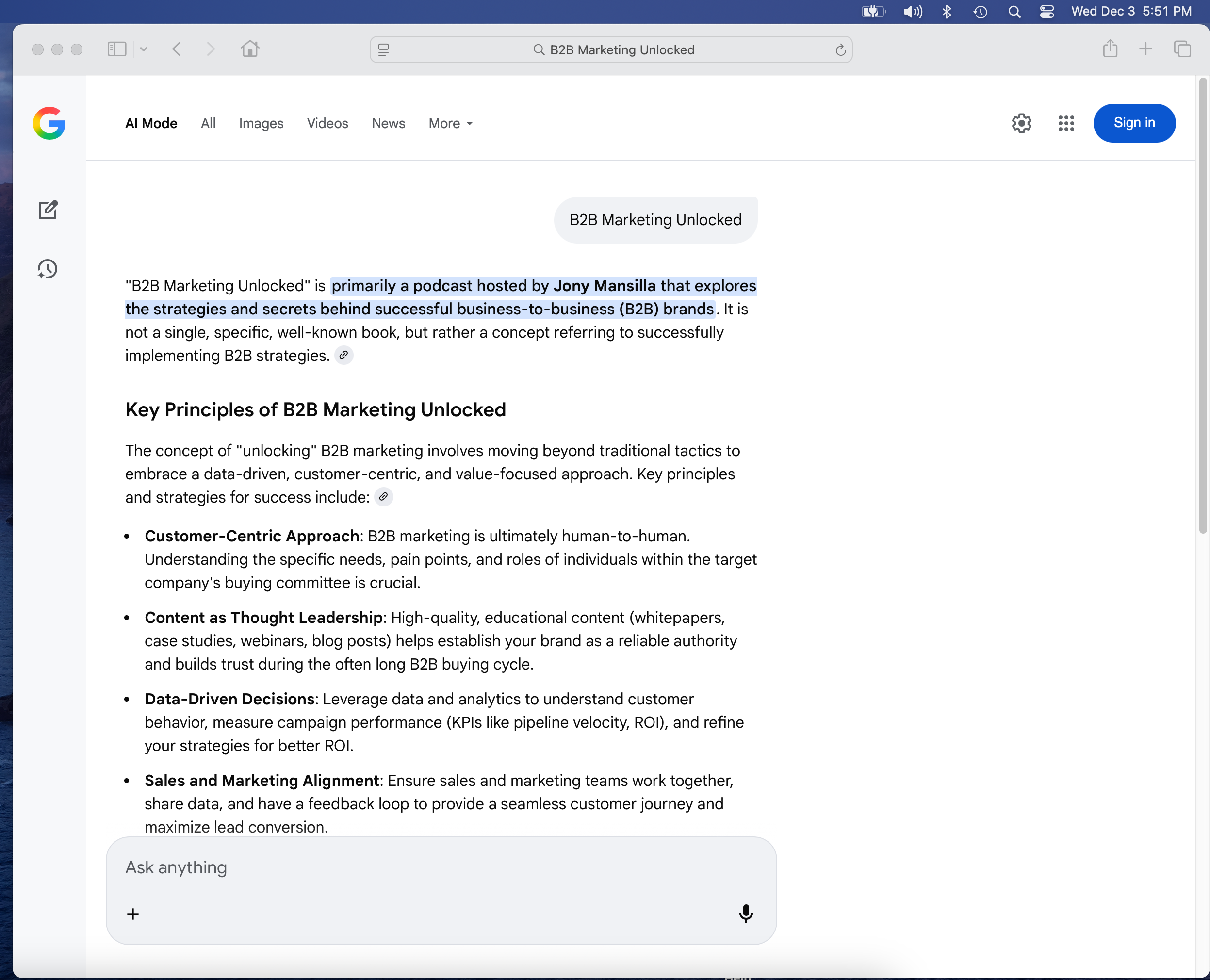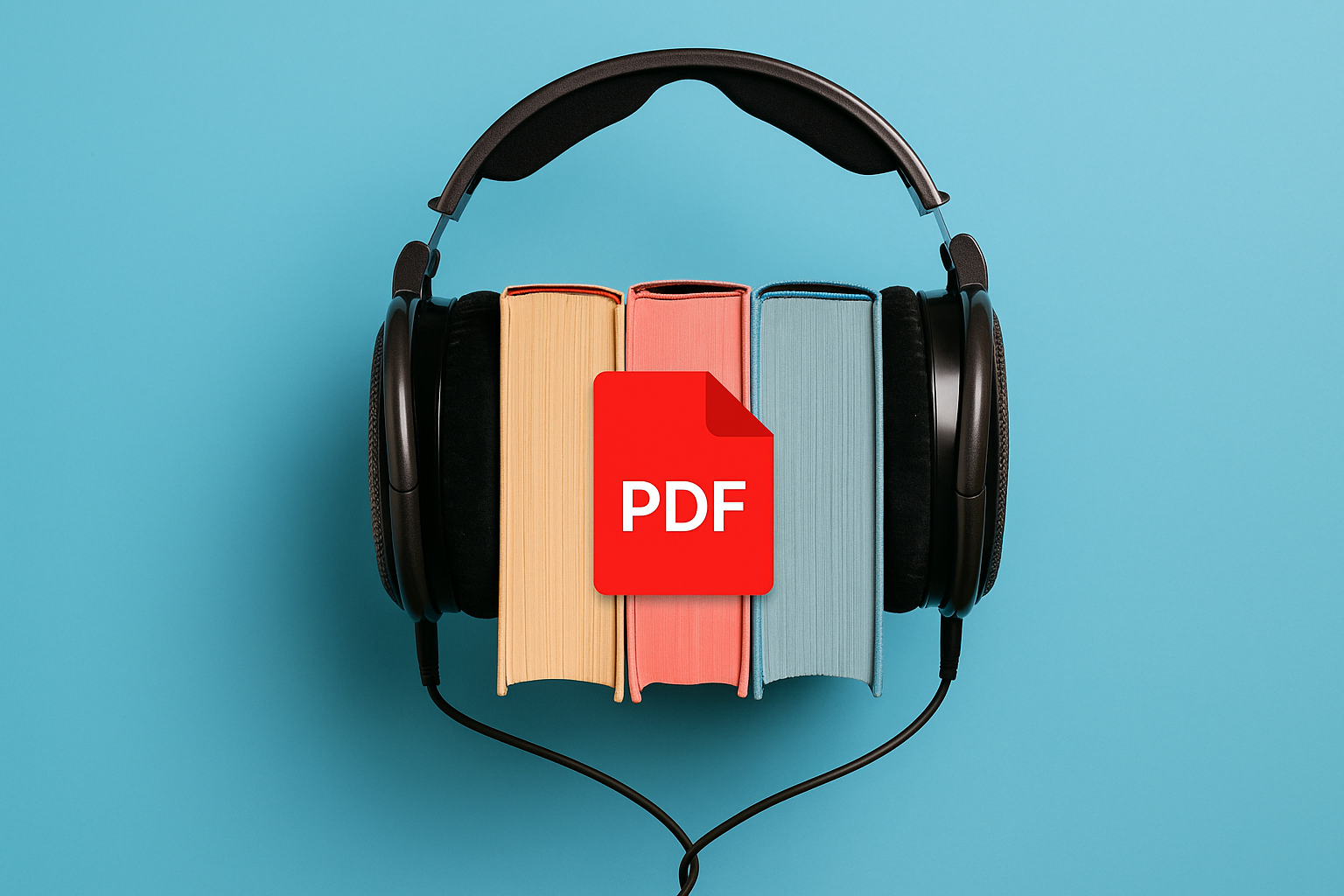Results in 7 Days
Ranked #1 on Google for “B2B Marketing Unlocked”
Ranked #1 in Google AI Overview
ZERO social promotion
ZERO prior YouTube audience
Landing page became top traffic source
These results were achieved with a brand new show, zero existing audience, and no ads. Here is exactly how we did it.
-
Launching a new B2B podcast in a crowded market is not easy. Most shows take months to gain traction, and many never appear in relevant search results at all. But with a strategic launch process and SEO-focused execution, we ranked our brand-new podcast, B2B Marketing Unlocked, number one on Google and in the Google AI Overview just seven days after release.
This case study breaks down exactly how we did it and why this approach works for B2B and enterprise companies looking to launch a podcast that is not just content, but a real demand generation asset.
The Challenge
We set out to create and launch a podcast that would attract B2B leaders, marketers, and enterprise decision makers. From day one, our goal was simple but ambitious:
Make the podcast discoverable on Google and AI search as fast as possible.
When we first searched for the term B2B Marketing Unlocked in late November, the results were not related to our podcast at all. Google showed generic marketing articles, industry education pieces, and high authority sites. We had zero ranking, zero presence, and zero YouTube followers.
This is where most B2B podcasts struggle. They produce content without aligning their show name, structure, metadata, and distribution with SEO intent. We wanted to prove what can happen when you launch with strategy.
Our Approach: A Strategic Podcast Launch Designed for SEO
While the show ranked in seven days, the preparation leading up to the launch was intentional. For our clients, this planning phase typically takes 4 to 8 weeks, which includes:
Developing a strategic podcast name with clear SEO potential
Crafting the show description and positioning
Designing the cover art
Writing and recording the trailer
Building the landing page
Setting up distribution across all platforms
Creating the blog format and content system
Recording and editing the first three episodes
This prep ensures the podcast launches as a fully formed content engine, not just another audio file.
The assets we launched with:
A podcast trailer (Nov 25, 2025)
A video trailer on YouTube
Episode 1 released one week later
A full podcast landing page inside our business website
A long-form podcast blog for Episode 1
Audio and video distribution on all major platforms
This gave Google multiple high quality signals tied to the same keyword.
Ranking #1 in Just Seven Days
By December 3, 2025, just seven days after the trailer launch, the results were in:
These rankings immediately increased qualified traffic from B2B leaders to our business website, strengthening awareness for our agency without any paid promotion. And unlike social posts that disappear in hours, these rankings keep working every day, creating ongoing passive discovery for the show and our business.
The podcast ranked #1 on Google for the exact search term B2B Marketing Unlocked
It ranked #1 in the Google AI Overview
The landing page quickly climbed into the top pages of our website traffic report
Organic traffic from B2B leaders began increasing
The YouTube episode and the podcast blog gained visibility with zero social promotion
We achieved this without running ads, without posting on social media, and without an existing YouTube audience. All visibility came from strategic SEO alignment and publishing high quality audio, video, and written content at the same time.
Why It Worked
1. The podcast name matched real search intent
Our show name, B2B Marketing Unlocked, is both unique and keyword-rich. It gave Google a clear and obvious target to index.
2. The landing page lived inside our main company website
Instead of creating a separate domain, we hosted the podcast page inside jonystudios.com. This meant the new page inherited:
Existing domain authority
Trust signals
Traffic patterns
Internal linking opportunities
This dramatically accelerated ranking. This is something we recommend to every B2B company launching a podcast.
3. We launched with multi-format content
Google loves topic clusters. We launched with:
Audio
Video
A written blog
A landing page
Platform metadata
A trailer
All supporting the same keyword. This creates a strong topical footprint immediately.
4. Consistency across all platforms
The same name, description, keywords, and messaging appeared on:
YouTube
Spotify
Apple Podcasts
Captivate
The Jony Studios site
The blog post
This removed ambiguity for search engines and reinforced the brand.
While every niche and competitive landscape is different, this launch demonstrates the speed and impact possible when a podcast is built from day one with SEO and demand generation strategy in mind.
Why B2B Podcasts Should Not Focus on Virality
A B2B podcast is not about going viral or chasing views. Unlike consumer podcasts, the goal is not mass reach. It is about reaching the right people. When your ideal buyers discover your company through high-quality conversations, the result is stronger trust, higher intent, and shorter sales cycles.
This launch was successful not because it generated thousands of views, but because it ranked at the top of Google and AI Search where decision-makers go to research solutions. Visibility in front of the right audience is what drives real B2B results, and this is exactly why we build podcasts this way.
Why This Matters for B2B and Enterprise Companies
Most corporate podcasts fail because they launch without strategy. They publish episodes but never gain traction, never rank, and never generate demand.
This case study demonstrates what is possible when your podcast is built as a strategic content system, not just an audio show.
A podcast that ranks on Google and AI search gives your business:
More visibility than social alone
Passive discovery from your ideal buyers
Authority and trust through owned content
A steady stream of multi-purpose assets
A foundation for demand generation
Stronger brand positioning in your niche
This is the future of B2B podcasting.
Our Podcast Launch Framework
At Jony Studios, we help B2B and enterprise companies launch strategic podcasts using a proven 4 to 8 week process that includes:
Naming and positioning for SEO
Trailer scripting and production
Guest strategy
Full video and audio production
Landing page development inside the company’s main site
Episode blogs designed for search
Social content systems
Show notes, metadata, and AI search optimization
Video clips and shorts
Distribution across all platforms
Our goal is simple: Turn your podcast into a demand-generating asset that ranks, grows, and drives pipeline.
Ready to Launch a Podcast That Actually Gets Results?
If you are a B2B company or enterprise brand looking to launch a podcast that can rank on Google, drive demand, and position your business as a category leader, we would be happy to help.
Explore how we launch strategic B2B podcasts here, or reach out directly to discuss your goals.















